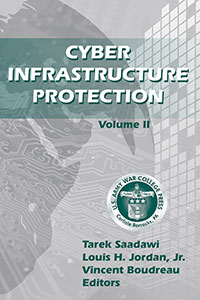U.S. Army War College >> Strategic Studies Institute >> Publications >> Details
Cyber Infrastructure Protection: Vol. II
Edited by Dr. Tarek N. Saadawi, COL Louis H. Jordan Jr, Dr. Vincent Boudreau.

- Added May 03, 2013
- Type: Monograph
- 281 Pages
- Download Format:
PDF (Recommended)
ePub (Mobile Devices)
Kindle Reader - Cost: Free
- Send this page to a colleague.
- Alert me when similar studies are published
Brief Synopsis
View the Executive Summary
Increased reliance on the Internet and other networked systems raise the risks of cyber attacks that could harm our nation’s cyber infrastructure. The cyber infrastructure encompasses a number of sectors including: the nation’s mass transit and other transportation systems; banking and financial systems; factories; energy systems and the electric power grid; and telecommunications, which increasingly rely on a complex array of computer networks, including the public Internet. However, many of these systems and networks were not built and designed with security in mind. Therefore, our cyber infrastructure contains many holes, risks, and vulnerabilities that may enable an attacker to cause damage or disrupt cyber infrastructure operations. Threats to cyber infrastructure safety and security come from hackers, terrorists, criminal groups, and sophisticated organized crime groups; even nation-states and foreign intelligence services conduct cyber warfare. Cyber attackers can introduce new viruses, worms, and bots capable of defeating many of our efforts. Costs to the economy from these threats are huge and increasing. Government, business, and academia must therefore work together to understand the threat and develop various modes of fighting cyber attacks, and to establish and enhance a framework to assess the vulnerability of our cyber infrastructure and provide strategic policy directions for the protection of such an infrastructure. This book addresses such questions as: How serious is the cyber threat? What technical and policy-based approaches are best suited to securing telecommunications networks and information systems infrastructure security? What role will government and the private sector play in homeland defense against cyber attacks on critical civilian infrastructure, financial, and logistical systems? What legal impediments exist concerning efforts to defend the nation against cyber attacks, especially in preventive, preemptive, and retaliatory actions?
You may also be interested in the following titles:
-

Armed Robotic Systems Emergence: Weapons Systems Life Cycles Analysis and New Strategic Realities -

Evaluation of the 2015 DoD Cyber Strategy: Mild Progress in a Complex and Dynamic Military Domain -

Closer Than You Think: The Implications of the Third Offset Strategy for the U.S. Army -

Toward a NATO of the Gulf? The Challenges of Collective Defense Within the GCC -

Strategic Landscape, 2050: Preparing the U.S. Military for New Era Dynamics -

The Clash of the Trinities: A New Theoretical Analysis of the General Nature of War
Also by the /Editors:
Cyber Infrastructure Protection: Vol. III
Arms Control and European Security
Cyber Infrastructure Protection
View other pubs in the following categories:
Military Change and Transformation
Military Strategy and Policy
21st Century Warfare
Future Technology
-
Download it Now!
- Download Format:
PDF (Recommended)
ePub (Mobile Devices)
Kindle Reader - PDF File Size: 2.94MB
- Download Format:
-
Hardcopies
- Study is: Available via Download Only
- View Cart
- All hardcopies are free of charge, shipping inclusive.
- For out of stock or digital only publications, refer to the new GPO on-demand site. For a small fee, recieve many prior publications. Click here to visit.
- All materials on our website are available as a free download.

